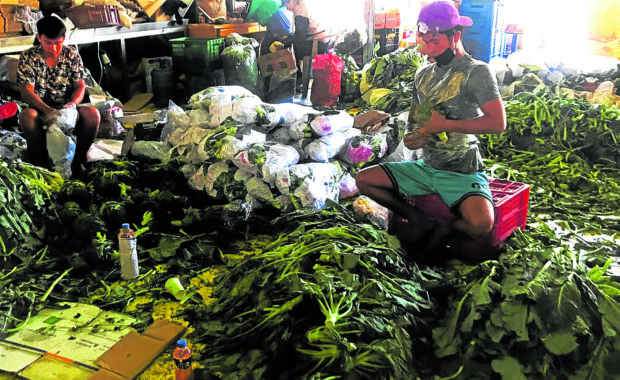Rise of ‘butterfly’ workers alarms Cordillera execs

NOTHING TOO MENIAL | Young Benguet workers trim vegetables at Benguet Agri Pinoy Trading Center in the capital town of La Trinidad in this photo taken on March 28, 2023. Labor officials have raised concerns that many young people no longer stay in one job for long, including in small enterprises like vegetable trading firms. (File photo by VINCENT CABREZA / Inquirer Northern Luzon)
BAGUIO CITY, Benguet, Philippines — “Butterfly” workers have become a growing concern for labor officials in the Cordillera despite an improved 97.3-percent employment rate in the highland provinces of Ifugao, Benguet, Kalinga, Apayao, Abra, and Mountain Province as of April, experts revealed last week.
“Butterfly” refers to working young people who rarely stay long at a company or business enterprise and who flit from job to job, which has upset traditional small, medium, and big businesses, said Romelda Escaño, Baguio’s public employment service officer.
This concern was among the labor-related issues that were raised when she attended a briefing on this year’s World Cafe of Opportunities, an annual job matching and facilitating program of the Technical Education and Skills Development Authority, which was held here on Aug. 16.
Escaño said she secured feedback regarding “butterfly” workers from human resource officers of Manila-based companies that recruit employees from the summer capital, particularly the business process outsourcing industry, “which operates in a quota-driven environment.”
Local hotels have also expressed their difficulty in hiring “loyal” workers, she said.
Article continues after this advertisementButterflies are a global phenomenon that the government had anticipated, so training and incentive programs have been put up to correct the work behavior of the youngest members of the labor force, said Nathan Lacambra, Cordillera director of the Department of Labor and Employment.
Article continues after this advertisementStudy needed
But he said a comprehensive study would also be necessary to determine the scope and impact of butterflies on the Cordillera economy, which surged in 2022 with a gross regional domestic product of 8.7 percent.
Last month, the region’s employment rose from 94.9 percent in April last year to 97.3 percent in April this year. In January, employment was at 96.7 percent.
The Philippine Statistics Authority has also been tracking a sharp decline in Cordillera unemployment, from 5.1 percent in April last year to 2.7 percent in April this year.
Government statisticians have yet to establish how many young workers belong to today’s upland labor pool of about 1.258 million, Lacambra said.
In July, Job David Manalang, Cordillera deputy director of the Commission on Population and Development (formerly the Population Commission), said over 40 percent of the Cordillera’s 1.79 million population are young. He said 28 percent of that age-group are toddlers and children ages 14 and below.
Stereotypes
Some companies attribute the butterfly syndrome to stereotypes about millennials and Gen Z (Filipinos born shortly before and during the first decade of the 21st century), such as their being “impatient,” Escaño said.
The stereotype also defines this working age-group as “technologically advanced but always geared towards immediacy [or immediate gratification],” she said.
“What we are looking at right now is the changing landscape… Our graduates today do not have the traditional values of the workforce from before—their staying power, loyalty [to one employer] and patience,” Escaño said.
However, the young workforce’s frequent movement could have also been triggered by the national economy, with its limited job prospects, high living costs and unstable inflation, Lacambra said.
“Mataas ang youth unemployment natin (We have a high youth unemployment rate) at the national level,” he said.
The government has turned back to schools to help coach future workers about their prospects. Lacambra said guidance counselors have been provided the tools to provide teens with “labor market information” to help them decide what careers to take.
Low birth rate
In a separate news conference last July, Manalang said the Cordillera’s low birth rate should help stabilize the economy.
According to the 2022 National Health Demographics Survey, the average Cordillera mother gives birth to two children during her lifetime, which means that fewer people would be competing for resources.
Agriculture, the largest but still underperforming industry in the Cordillera, would be most affected by the reduced birth rates, given that the average age of the Filipino farmer is in the mid-50s, Manalang pointed out.